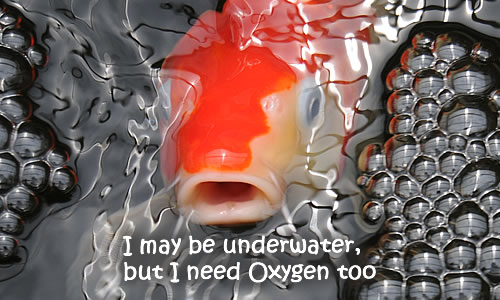How to Solve and Avoid Low Oxygen Problems
With the warm weather we have all been waiting for finally on its way you may need to make sure fish enjoy it as much as you do. As temperatures start to increase, the ecology of a pond will change. Increased temperatures will increase the activity of your fish and hence the consumption of Oxygen, whilst at the same time the rise in water temperature reduces it’s ability to carry oxygen, these factors in severe cases can be fatal to your fish.
For plants, fish, amphibians, wildlife and even many forms of bacteria, an environment which is rich in oxygen is critical. Although oxygen is present in water and the air around us, ensuring a sufficient quantity of oxygen within a pond is not something that should be left to chance
What happens in natural ponds, why don’t they need any help?
In most wild ponds, nature has a very brutal way of establishing a balance. They normally have much smaller quantity of fish per 1000 gallons of water than there would be within a garden pond, allowing waste products from the fish to be diluted without causing them harm. Because of this low population, there is normally plenty of oxygen for the fish population. However in natural ponds sometimes things go wrong. If a very fast growing pond plant overtakes the pond (such as parrot’s feather or even blanket weed), or if the fish population suddenly explodes. It can cause a massive reduction of oxygen during hot humid summer nights and in extreme cases, kills most of the fish population (usually killing the largest fish first).
Why do some plants have this effect, I thought they were Pond Oxygenators?
Although plants don’t breath in the same way we do, the cells within plants continually use oxygen to help fuel growth and repair (this is called cellular respiration). This process happens 24 hours a day and carbon dioxide is given of as a by-product. Fortunately, during daylight hours another process called photosynthesis more than corrects the balance by producing oxygen as a by-product of absorbing energy from sunlight. So although plants can boost oxygen during the day, they do not at night and in fact are one of the oxygen consumers.
Click Here to go to our Blanket Weed Treatments Page
Can I add additional Oxygen to my pond?
In garden fish ponds the balance between fish and plants is more commonly in favour of the fish, with plants often as decoration only. This is where nature needs a helping hand to keep the oxygen levels up. In addition to plants Oxygen is added to the water wherever water comes into contact with air, so the greatest quantity of Oxygen enters your pond at the surface, so ensuring a good circulation of the pond is the first step to keeping Oxygen levels up. Your pump should be at the bottom of the pond, where the oxygen content is lowest and should push water up to the surface and ideally spread it out across the surface of the pond. Adding a fountain or waterfall all increase contact time between the water and air and give more opportunity for the vital Oxygen to be absorbed.
For more information on these products, click the following links
Blanket Weed Treatments : Filter Kits : Pond Fountain Pumps : Pond Spitters
There are also other ways to put water in contact with air. Pond air pumps can be a fantastic way to improve the oxygen levels within a pond. Although each individual bubble may be tiny, releasing millions of bubbles into the bottom of a pond with an air pump and air stones, keeps the air in contact with the water as the bubbles rise to the pond surface. In addition to the direct transfer of oxygen achieved by this process, an added benefit is that the rising bubbles will drag de-oxygenated water from the base of the pond back to the surface for re-oxygenation. The Oase OxyTex CWS air stone is particularly good at releasing thousand of very fine air bulbs and also acts as a boost to your filter system.
For more information on these products, click the following links
Pond Air Pumps : Air Pump Accessories
The time of lowest Oxygen levels are normally at dawn and often the most common sign of an Oxygen problem is when the fish are up at the surface first thing in the morning with their gills moving quickly. If you see this then you need to act quickly as your fish maybe in danger and sadly it’s always the largest fish which die first. A very useful fast acting treatment is Oase’s AquaActive Oxy Plus, which actively releases Oxygen quickly straight in to the water because it is a hydrogen peroxide granulate fixed on a carbonate. When it becomes wet the carbonate goes into solution and the peroxide starts to react with the water. The result is pure oxygen and water. Due to the fact that the carbonate goes into solution very slowly we have a immediate but long lasting effect. This treatment can be added to your pond before a problem exists and will spring in to action as and when needed.
For more information on this product, click the following link: Oase OXY Plus
You can never have too much oxygen in a pond and many experts believe fish are healthier in environments which are rich in oxygen, and they would recommend adding air pumps to almost all fish ponds as a matter of course not just when and if the Oxygen levels are dangerous.
The simple rules to follow are:
A) DO NOT over stock your pond. As a rule of thumb a pond should be stocked with no more than 100” of fish (excluding their tails) per 1000 gallons of water (5.5cm per 100L). If you exceed this limit you should be very careful to ensure the level of oxygen in your pond does not fall too low (particularly at night) and be carefully of fish fry which as they grow will greatly add to the oxygen consumption.
B) DO NOT allow oxygenating plants, blanketweed or green water to overtake your pond. Remember that although in the day plants produce more oxygen than they use, at night they don’t produce oxygen at all, but they do produce a lot of carbon dioxide.



